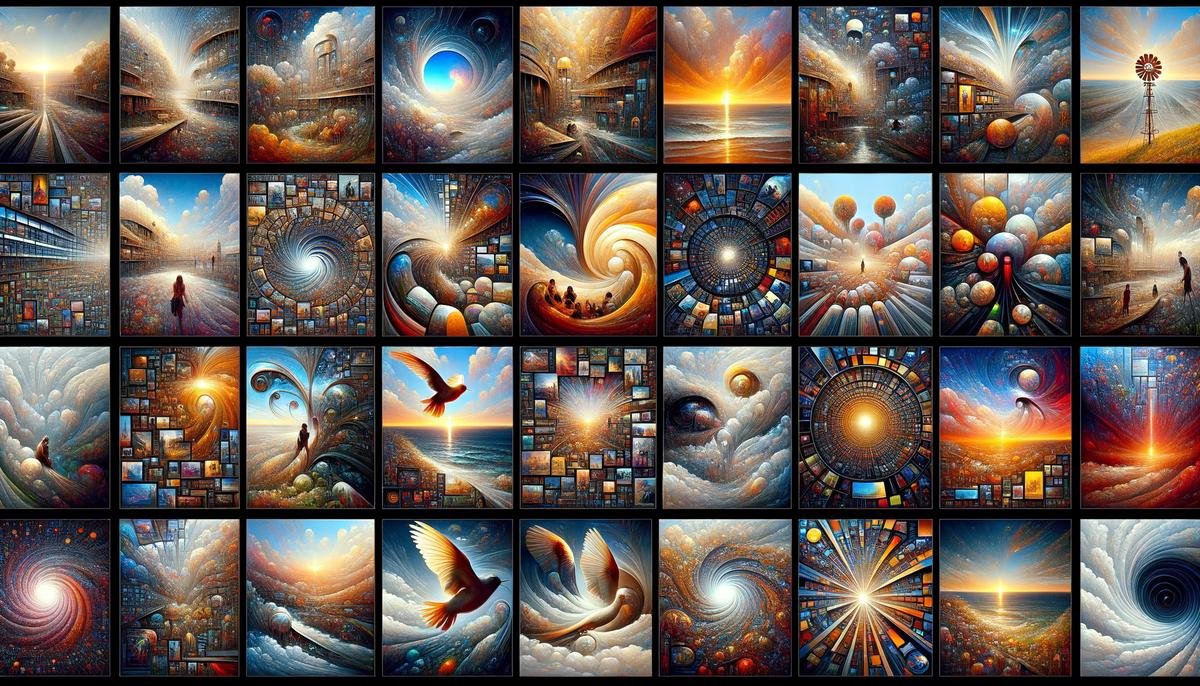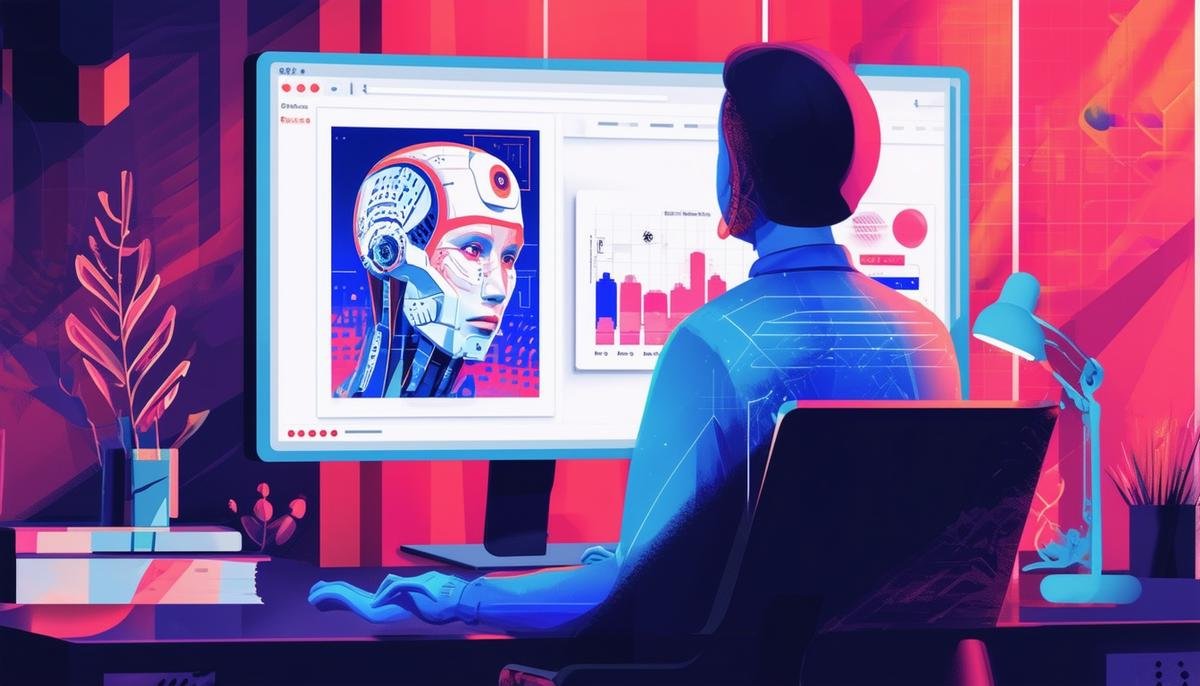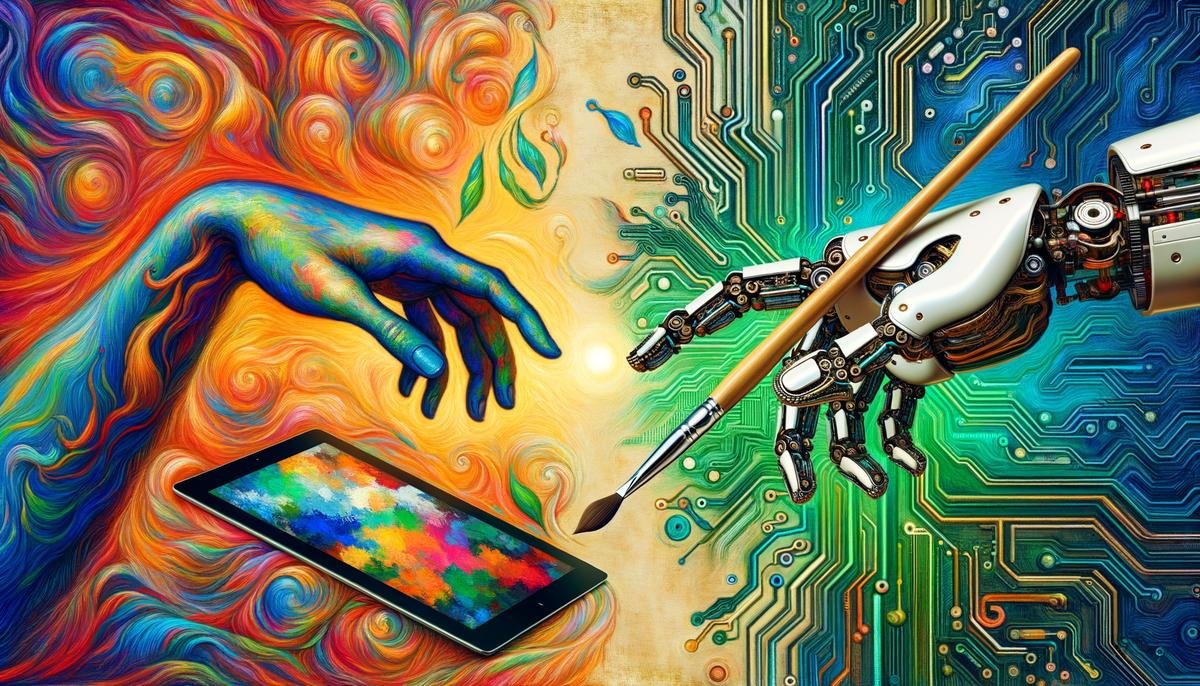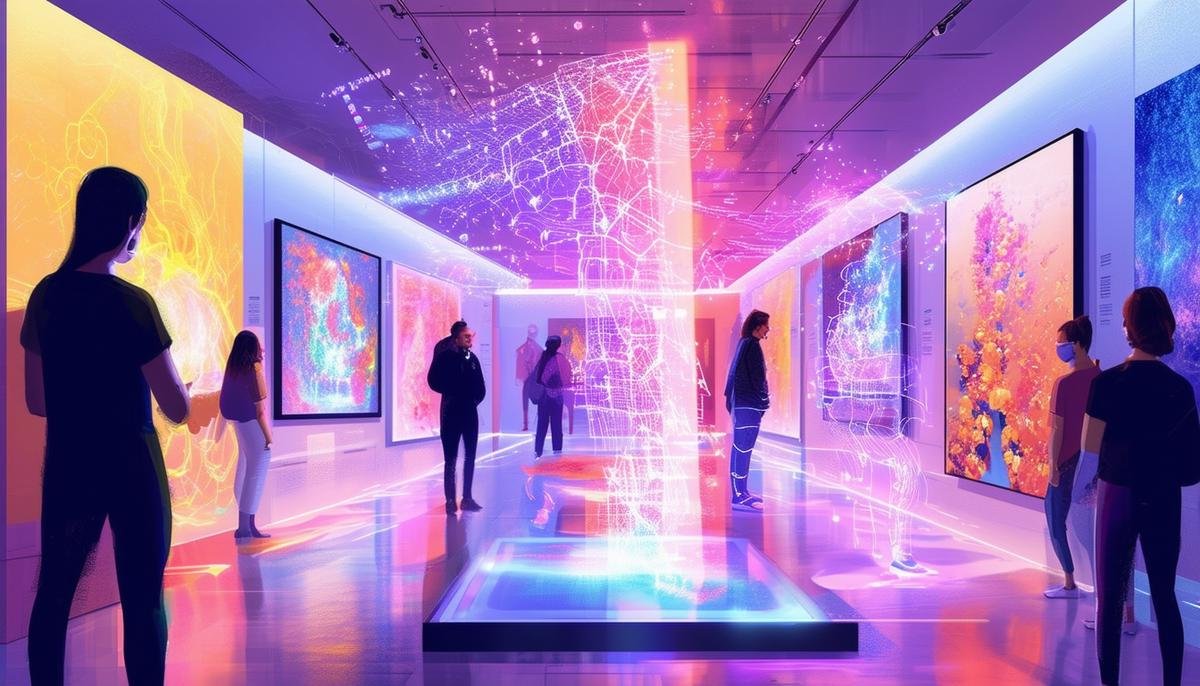The Evolution of Generative AI in Art
Artists have played with code since we first had code, but we’ve never seen anything like the boom of generative AI. In just a couple of years, tools like DALL-E, Midjourney, and Stable Diffusion have changed the game. Artists and designers use these tools to explore new subjects and styles. They’re integrating AI-generated visuals into canvases, videos, and even virtual reality.
These creations raise the question: can machines be creative? And could they replace artists? AI is already shaking up areas like illustration and photography. It’s streamlining processes and even taking over some tasks completely, like swapping backgrounds in photos.
Generative AI might revolutionize art, introducing new forms and techniques, similar to how photography freed painting and led to new movements like Impressionism and Cubism. Imagine three potential paths:
- Artisanship making a comeback.
Artists might turn back to traditional skills like painting and sculpting. But advanced AI might soon handle brushes and canvases on its own, questioning the value of human craftsmanship once again. - Redefining creativity.
From the Romantic era’s “creative genius” to today’s “artificial creativity,” the concept keeps evolving. We still can’t pin down what creativity is. It’s always in flux, open to interpretation. - Écriture automatique as an artistic strategy.
A century ago, surrealists used “automatic writing” to create without conscious control. This is echoed in today’s use of generative AI for art. DALL-E’s name, inspired by the surrealist Salvador Dalí, hints at this connection. Like Dalí, who saw himself as a medium for his unconscious, AI art shifts authorship in new ways.
Generative AI adds to this mystery. We can’t fully grasp what happens inside neural networks, much like a painter seeing a blank canvas. Training an AI with past images is like an artist learning from art history.
Generative AI revitalizes art history trends and ushers in a new era. AI becomes a partner in creativity, aiding the birth of new forms. Today, AI helps us see patterns and extract meaning. In art, this means “artificial augmented creativity,” much like photography did 200 years ago.
Capabilities and Features of DALL-E 2
DALL-E 2 is a quantum leap in generative AI. It interprets textual prompts to create high-quality images, pushing the boundaries of digital creativity. This ability to transform words into visuals opens up endless possibilities for artists, designers, and creatives from all walks of life.
Imagine typing “a vintage photo of a corgi on a beach,” and within moments, having a realistic, aesthetically pleasing image that captures that exact vision. That’s the magic of DALL-E 2. Its underpinning technology, known as Generative Adversarial Networks (GANs), consists of two neural networks working in tandem: one generates the image, and the other critiques it, constantly refining the output until it meets the desired criteria.1 This dual-network approach allows for an impressive level of detail and fidelity in the generated images.
DALL-E 2 excels in understanding complex and nuanced textual prompts. Its advanced natural language processing capabilities mean that it doesn’t just recognize keywords but understands context and subtleties, making the resulting imagery more coherent and engaging.
DALL-E 2’s versatility is another standout feature. It can generate images in a wide range of styles, from photorealistic depictions to abstract art. This capability means artists and designers have a powerful tool that can adapt to various creative needs.
DALL-E 2’s edge also extends to the quality of its outputs. Thanks to rigorous training on diverse datasets and advanced fine-tuning, the images produced are high-resolution and exhibit nuanced textures and lighting effects that breathe life into the visuals.
DALL-E 2 is designed with ethical considerations in mind. The developers have implemented safeguards to prevent the generation of violent, hateful, or adult content, ensuring that the tool is used responsibly.
In essence, DALL-E 2 is a game-changer in generative AI, offering unparalleled functionality and quality. By bridging the gap between textual prompts and high-quality imagery, it empowers artists to explore new creative vistas, democratizing art in a way that was once unimaginable.

Impact on the Creative Industry
DALL-E 2’s influence reaches far and wide across the creative industry, transforming digital art, design, and media in unprecedented ways. By streamlining creative processes and enhancing productivity, this powerful AI tool opens up new avenues for artistic expression, allowing creatives to push boundaries and explore uncharted territories.
In digital art, DALL-E 2 allows artists to quickly prototype ideas and iterate designs without being bogged down by the nitty-gritty details of manual creation. Artists can focus more on the conceptual and strategic aspects of their work, experimenting with novel visual styles. The speed and efficiency provided by DALL-E 2 leave more room for creativity and innovation, making the artistic process both exciting and efficient.
Graphic designers are harnessing the power of DALL-E 2 to enhance their productivity and workflow. With DALL-E 2, designers can generate diverse visual assets swiftly, ranging from icons and illustrations to complex layouts. This accelerates the design process, allowing for quicker client approvals and more iterations within tighter deadlines.
In media and entertainment, DALL-E 2 is reshaping how visual content is produced. Filmmakers and animators can use AI-generated storyboards to visualize scenes before committing resources to full production. Similarly, publishers and advertisers can utilize AI-generated images for their campaign needs, ensuring that the visuals are eye-catching and relevant.
Beyond efficiency, DALL-E 2 is expanding the horizons of what is possible in creative expression. It encourages experimentation with styles and formats that might have been deemed too time-consuming or risky in a traditional workflow. This artistic freedom drives the evolution of visual culture, encouraging a richer and more diverse range of artworks.
The democratization of art facilitated by DALL-E 2 is particularly noteworthy. Emerging artists, who might have previously lacked access to high-end tools and resources, can now leverage AI to bring their visions to life. This inclusivity fosters a broader spectrum of voices and ideas in the art world, promoting diversity and innovation.
However, it’s important to acknowledge the concerns within the creative community regarding job displacement and artistic authenticity. While AI tools like DALL-E 2 streamline processes and introduce new levels of efficiency, they also raise questions about the future role of human artists and designers.2 It’s crucial to strike a balance where AI acts as an enabler rather than a replacement, augmenting human creativity instead of overshadowing it.
In essence, DALL-E 2 is a catalyst for a creative revolution. By augmenting human capabilities and democratizing access to advanced creative technologies, it paves the way for a more dynamic, inclusive, and innovative artistic future. As we continue to explore the potential of AI in creativity, the synergy between human ingenuity and machine intelligence will undoubtedly lead to extraordinary new possibilities in art, design, and media.

Ethical Considerations and Challenges
As we explore the realm of AI-assisted creativity, it’s essential to unravel the ethical considerations and challenges that come along with these technological advancements. The conversation around the ethical implications of using AI in art is multifaceted, encompassing issues of copyright, authorship, and the potential for misuse.
One of the primary ethical concerns is the issue of copyright. AI tools like DALL-E 2 are trained on vast datasets comprising millions of images, many of which are copyrighted works. This means the AI has been exposed to and has learned from content created by human artists, raising questions about the ownership of AI-generated images. When an AI generates art based on these learned patterns, does it infringe upon the original creators’ rights? This ambiguity has led to a heated debate within the artistic community.
Some artists argue that AI-generated creations mimic their distinct styles, leading to what feels like an infringement on their artistic property. For instance, noted fantasy artist Greg Rutkowski has voiced concerns over the widespread use of his name in AI prompts to replicate his signature style without consent.1 The fear is that this not only dilutes the uniqueness of their work but also undermines their brand, making it harder for them to distinguish their original creations from AI-generated imitations.
To address this, some AI developers and artist collectives have initiated tools like “Have I Been Trained?” by Spawning. This tool allows artists to check if their work was used to train AI models like Stable Diffusion and opt out of future datasets. However, this after-the-fact measure does little to mitigate the impact of prior use, leading to calls for more proactive and transparent data usage policies.
Authorship presents another complex dilemma. Traditionally, the creation of art is a deeply personal and human endeavor, imbued with the creator’s spirit, emotions, and intent. When AI enters the equation, it blurs these lines. If a piece of art is generated by an AI based on a prompt supplied by a human, who owns the resulting work? Is it the person who provided the prompt, the developers of the AI, or the AI itself? As society grapples with these questions, legal frameworks must evolve to offer clarity and protection for all stakeholders involved.
The potential for misuse of AI-generated content cannot be ignored. Without proper guidelines and safeguards, generative AI tools might be used to create deepfakes, spread misinformation, or produce harmful and offensive visuals. Recognizing this, the developers of DALL-E 2 have implemented several measures to foster responsible use, such as:
- Removing explicit content from training datasets
- Filtering out prompts that violate content policies
- Employing both automated and human monitoring systems to curb misuse
These efforts reflect a growing awareness of the ethical responsibilities associated with AI technology. However, the onus also lies on users to approach AI with integrity and respect, ensuring their creations do not cause harm or infringe upon the rights of others. Collaboration between AI developers, artists, legal experts, and policymakers is essential to develop comprehensive regulations that protect individual rights while promoting innovation.
Ultimately, the intersection of AI and art is a dynamic space where technological prowess meets human creativity. The ethical considerations surrounding copyright, authorship, and misuse highlight the need for thoughtful dialogue and responsive policy-making. By addressing these challenges proactively, we can harness the incredible potential of AI in art responsibly and ethically.

Future Prospects and Human-AI Collaboration
The future of AI art is filled with promising advancements and intriguing collaborative ventures between human artists and AI. As we look into this rapidly evolving landscape, it’s clear that the coming years will see a proliferation of tools and systems that not only assist in artistic creation but also inspire new forms of expression.
Imagine AI as a co-creator that actively contributes to the creative process. This partnership transforms the way artists conceptualize and realize their ideas, offering fresh perspectives of innovation. For instance, while an artist may have a grand vision for a piece, AI can suggest variations, compositions, or even entirely new perspectives that the human mind might not have initially considered. This symbiotic relationship allows for a fusion of human intuition with the computational power of AI, leading to artworks that embody the best of both worlds.
One of the most exciting prospects is the potential for “interactive art.” With AI tools becoming more sophisticated, we can anticipate a future where art is not static but dynamic and responsive. Imagine walking through an art gallery where each painting changes subtly as you move, reflecting your mood or the ambient conditions of the room. Or consider interactive installations where viewers can influence the artwork in real-time through gestures or spoken words, creating a unique experience each time.
AI’s capabilities in pattern recognition and data analysis can unearth hidden connections and motifs within an artist’s body of work or even across different artists and historical periods. This could lead to the emergence of new art forms that blend disparate styles into coherent, innovative expressions. An artist might use AI to analyze their previous works, identifying underlying themes or techniques that can be amplified or contrasted in future projects.
The collaborative spirit of AI also stands to make a significant impact on educational and community-focused art initiatives. Imagine AI-powered platforms where budding artists can receive personalized feedback and tutorials tailored to their unique style and skill level. These tools can democratize access to high-quality art education, helping to nurture the next generation of creatives from diverse backgrounds.
The concept of “hyper-personalization” in art could take on new dimensions. Artists could leverage AI to create custom pieces for patrons, using data to reflect individual preferences, emotions, and memories within the artwork. This approach makes each piece deeply personal and taps into a growing desire for unique experiences.
However, as AI becomes an integral part of the creative process, maintaining the balance between human touch and machine precision is crucial. Artists will need to find ways to incorporate AI without losing the essence of their artistic voice, ensuring that the resulting works remain authentically human while benefiting from AI’s capabilities.
The AI tools of the future might also embrace more intuitive interfaces, making the technology more accessible to those who are not tech-savvy. Voice commands, natural language prompts, and even thought-driven input methods could become commonplace, allowing artists to interact with AI in more fluid and natural ways.2 This seamless integration can turn the creative process into a more spontaneous and organic endeavor.
We can expect AI to play a significant role in collaborative projects that span multiple disciplines. For example:
- An artist
- A musician
- A writer
These individuals could all work together with AI to create multimedia experiences that weave visual art, soundscapes, and narrative into cohesive, immersive installations. These interdisciplinary collaborations have the potential to push the boundaries of what we define as art, opening up new realms of sensory and emotional engagement.
As we move forward, it’s evident that the future of AI in art is not just about enhancing existing practices but also about breaking new ground. The partnership between human creativity and AI offers a canvas for limitless exploration, where the constraints of traditional methods dissolve, and the possibilities become as expansive as our imaginations. The journey ahead is one of curiosity and discovery, where each new development in AI technology opens up further avenues for artistic expression.





